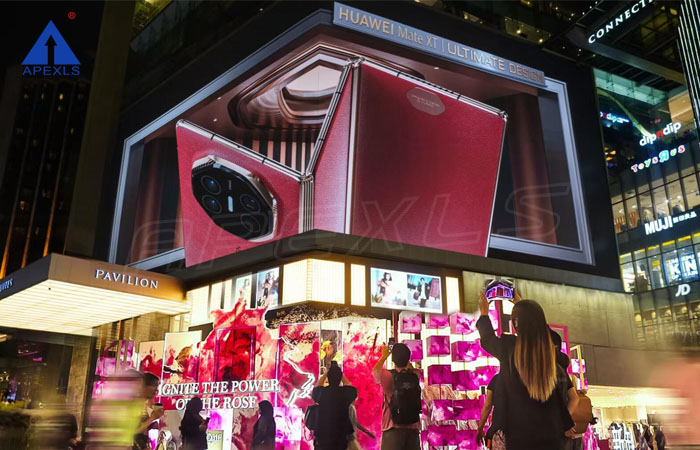Outdoor naked-eye 3D displays have become highly attractive visual focal points in urban landscapes, thanks to their ability to deliver stunning stereoscopic effects without requiring viewers to wear auxiliary equipment. Compared to indoor devices, they have unique characteristics in terms of technical principles, application scenarios, price structures, and selection criteria. Below, Apexls provides an in-depth analysis:
The core idea of outdoor 3D LED displays is based on binocular parallax. Advanced LED display technology allows viewers to perceive depth naturally. Through parallax barriers and lenticular lenses, each eye receives a unique image. The brain merges both images, creating a vivid 3D LED display experience.
However, outdoor LED display environments are challenging. Bright sunlight can distort images, so high-contrast LED panels are crucial. Apexls integrates adaptive brightness systems into every outdoor LED display solution. These systems automatically adjust to light conditions, maintaining clarity all day. As a result, even under strong light, 3D effects remain sharp and realistic.
In addition, outdoor LED display units feature wide viewing angles. Some Apexls models exceed 160 degrees, ensuring visibility from multiple positions. This innovation makes every 3D LED display suitable for public environments.
Outdoor 3D LED displays transform plazas, malls, and transport hubs. They provide immersive content that extends beyond the screen surface. For example, an Apexls outdoor LED display can make a car “drive out” of the screen. Such effects quickly capture attention and enhance advertising impact.
In transportation centers like airports and stations, 3D LED displays guide travelers. They show real-time information and promotional content in dynamic formats. As a result, communication becomes faster, clearer, and more engaging.
Outdoor LED display installations near cultural landmarks express local identity. They visually represent city stories, cultural icons, and digital art. These LED displays enrich urban space and promote tourism.
Even at expositions or amusement parks, outdoor LED displays build immersive entrances. Apexls 3D LED display systems enhance brand experiences through dynamic storytelling.

Case in point: The 1,250-square-meter outdoor naked-eye 3D display at Pavilion Kuala Lumpur in Bukit Bintang, Malaysia, featuring Huawei Mate XT advertisements.
The price of outdoor 3D LED displays depends on several variables. Screen size, pixel density, and LED display materials all influence costs. Small outdoor LED display panels (50–300㎡) cost from 300,000–2.5 million yuan. They are suitable for small retail exteriors or local event areas. Medium LED displays (300–600㎡) range between 2–4.5 million yuan. These are ideal for mall plazas and transportation zones. Large outdoor LED displays over 600㎡ exceed 4 million yuan. They often act as urban icons in busy business districts.
Additionally, weather resistance affects the LED display price. High-protection models (IP65 and above) resist dust and rain, adding 20–30% cost. Premium brands like Apexls, known for stable quality, may cost slightly more. However, their longevity and reliability make them more cost-effective long-term.
Selecting the right outdoor LED display requires careful evaluation. Resolution defines image detail; higher resolutions deliver sharper 3D visuals. For instance, an 8K LED display presents crisp and lifelike depth effects. However, resolution should match viewing distance and content type. For far-view screens, moderate resolution reduces cost without losing clarity.
Brightness and contrast are equally important in LED display selection. Apexls recommends brightness above 4500 cd/m² for outdoor installations. Dynamic brightness adjustment ensures optimal visibility and energy efficiency.
A wide viewing angle enhances 3D LED display performance. High-end Apexls models provide 160° visibility with consistent depth rendering. Response time under 5ms guarantees smooth playback and minimal motion blur.
Outdoor LED display panels must endure rain, wind, and heat. An IP65 or higher protection level ensures stability across seasons. Apexls designs every LED display with reliable waterproof and dustproof systems. Temperature resistance between -30°C to 50°C ensures durability in any climate. Moreover, reinforced frames improve wind resistance and installation safety.
Performance stability defines a professional outdoor LED display. Apexls integrates intelligent heat dissipation systems into all display structures. This design prolongs lifespan and minimizes energy loss. The company also supports multiple input formats and real-time content management.
Every LED display system from Apexls allows easy upgrades and scalability. As display technology evolves, firmware updates enhance long-term performance. Low-power LED chips and smart power management reduce operating costs.
While the initial LED display price may seem high, quality ensures long-term savings. Apexls offers installation, maintenance, and technical support for all models. Comprehensive warranties (2–3 years) further secure customer investment. After-sales service and global support networks strengthen reliability.
Outdoor naked-eye 3D LED displays redefine urban visual expression. They combine innovation, artistry, and engineering precision. With Apexls, every outdoor LED display becomes both a communication tool and an art form. By understanding the principles, prices, and performance of LED display technology, brands can invest wisely, ensuring durability and maximum visual impact. For expert consultation or custom LED display solutions, contact Apexls today.